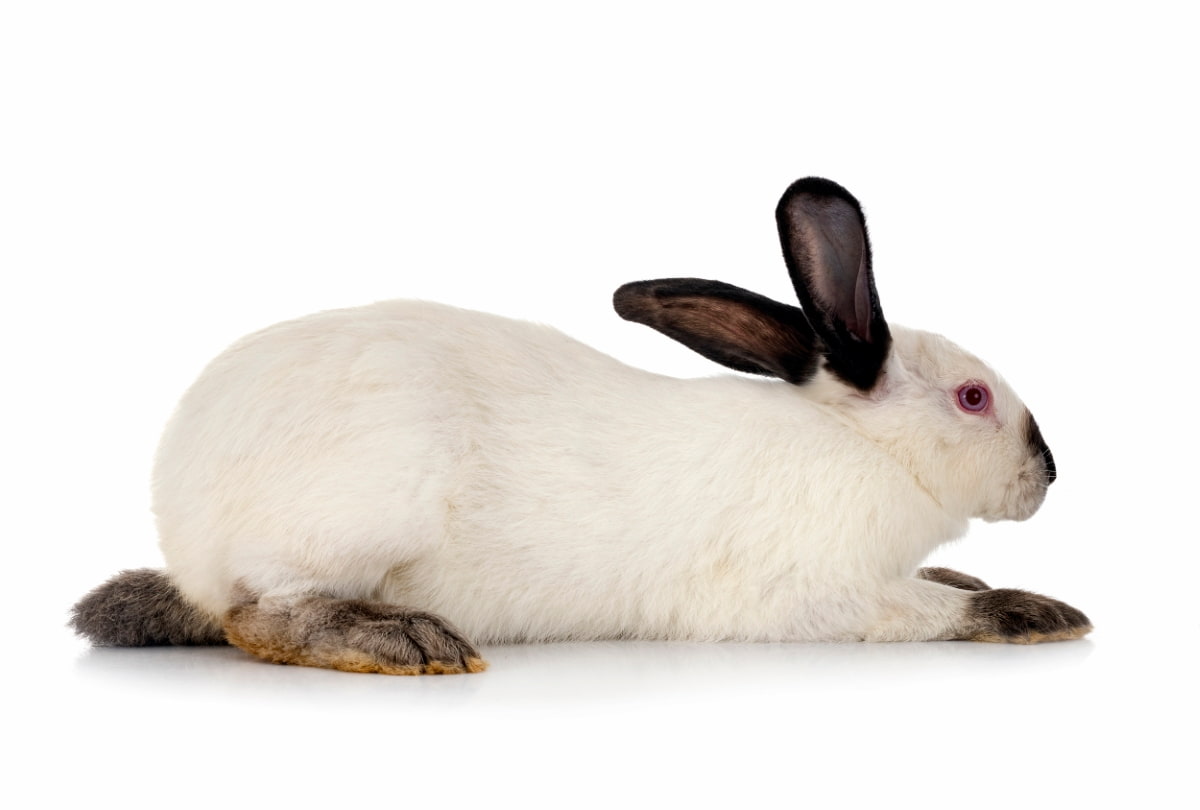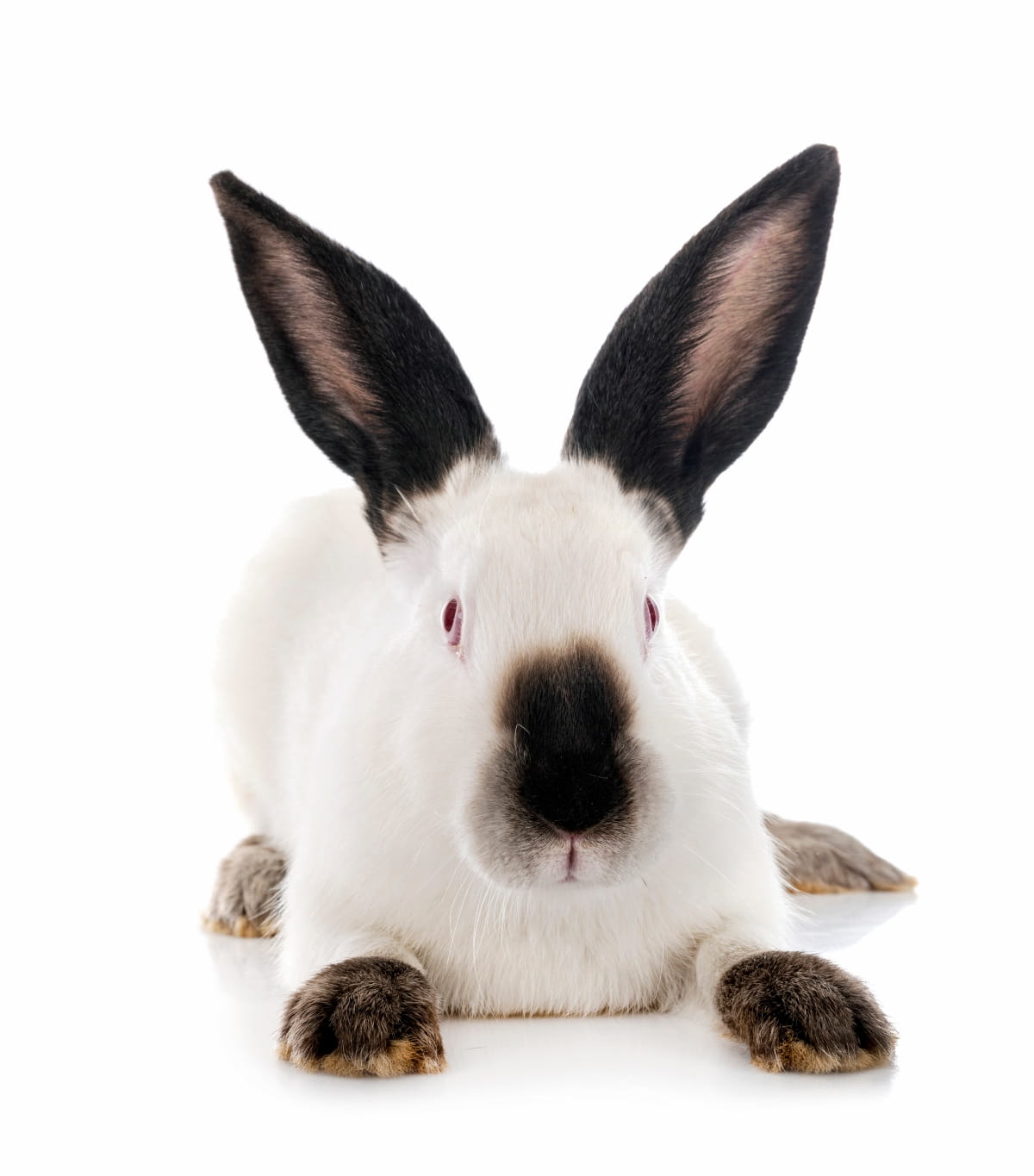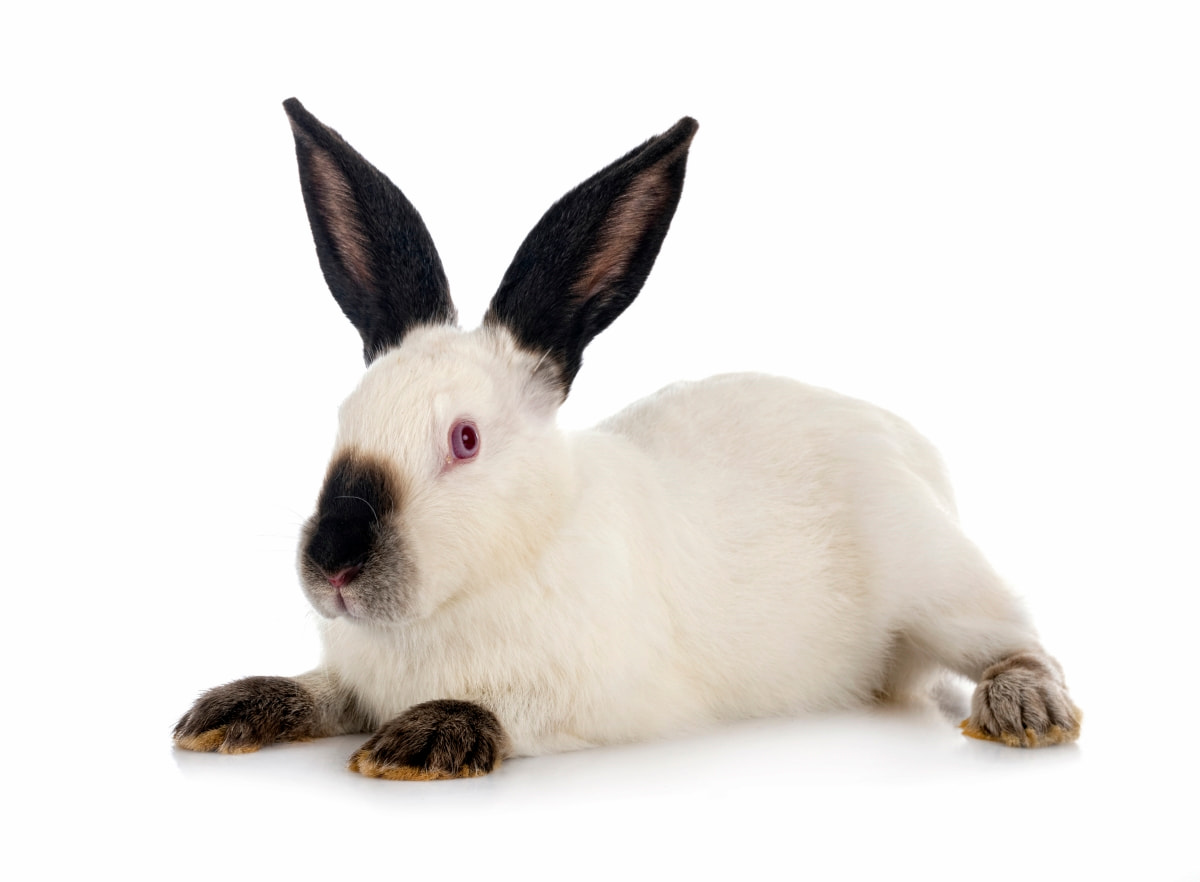Originally bred for their fur value and meat production, they have become popular as show rabbits and beloved pets. Californians are the most common breed in the United States. With their striking appearance and versatile nature, Californians have made their mark in both commercial production and the world of show rabbits. Californian rabbit lifespan is between 5 and 10 years when kept as pets.

Californian Rabbit: Origins and Characteristics
The Californian rabbit breed has an interesting history that dates back to the early 20th century. It was developed in California, hence its name, by crossing Himalayan and New Zealand White rabbits. Californians are known for their striking appearance. They have a white body with black points on their nose, ears, feet, and tail. With their attractive appearance and amiable temperament, Californian rabbits make wonderful pets for both beginners and experienced rabbit owners.
The physical characteristics of Californian rabbits make them highly desirable both as show animals and for commercial purposes. One of the most appealing characteristics of Californian rabbits is their friendly disposition. They tend to be docile and calm, making them great companions for families or individuals looking for affectionate pets.
The History of Californian Rabbits
Californian rabbits have an interesting history from the early 20th century. Their primary objective was to develop a rabbit with high-quality fur that could be used for commercial purposes. The result was a beautiful rabbit with striking markings – white fur on the body and black tips on the ears, nose, feet, and tail. However, it wasn’t until the late 1920s that Californian rabbits gained recognition as a distinct breed. They quickly became popular due to their excellent fur quality and efficient meat production capabilities.
Housing and Environment for Californian Rabbits
Providing suitable housing and environment is crucial for the well-being of your Californian rabbits. These furry creatures need a safe and comfortable space to thrive. A common choice is a rabbit hutch or cage that provides enough room for the rabbit to move around freely. Ensure the cage has solid flooring to prevent injury to its sensitive feet.
In case you missed it: Top 12 Benefits of Rabbit Manure Fertilizer in Agriculture

It’s important to remember that rabbits are social animals, so consider having more than one rabbit if possible. This will help prevent boredom and loneliness. However, ensure enough space for each rabbit within the enclosure. In terms of environmental factors, temperature control is vital. Californian rabbits can be sensitive to extreme temperatures, so keeping them in an area with stable ambient temperatures is crucial. Regularly clean their living area and replace dirty bedding to ensure cleanliness and hygiene.
Information About Californian Rabbit
| Breed Name | Californian Rabbit |
| Breed Purpose | Dual purpose. Raised for meat and fur production. They were also raised as pets. |
| Breed Size | Large |
| Size | Standard |
| Lifespan | 5-9 years |
| Body Type | Commercial |
| Temperament | Good-natured, easy-going |
| Suitable for Commercial Production | Yes |
| Good as Pets | Yes |
| Climate Tolerancea | All Climates |
| Rarity | Common |
| Country of Origin | United States |
Physical Appearance of Californian Rabbits: Coat Color, Body Shape, and Size
- Coat Color: As mentioned earlier, the Californian’s coat is predominantly white with contrasting black points. This combination creates an eye-catching contrast that sets them apart from other breeds.
- Body Shape: These rabbits have a well-proportioned body shape with a compact build. Their hindquarters are muscular and strong, allowing them to move swiftly when needed.
- Size: Adult Californian Rabbit weight is between 8-10 pounds. However, individual variations may occur depending on genetics and diet.
Californian Rabbit Temperament
Californian rabbits are known for their gentle and friendly nature. These bunnies are calm, making them great companions for adults and children. Are Californian rabbits friendly? One of the most endearing qualities of Californians is their docile personality. Another notable aspect of their temperament is their curious nature.
Californians love to explore their surroundings, often hopping around inquisitively to investigate new sights and smells. Providing them plenty of space to roam will keep these active bunnies happy. The temperament of Californian rabbits makes them wonderful pets for individuals or families looking for a friendly and low-maintenance companion.
Feeding and Nutrition for Californian Rabbits
A balanced diet will not only keep them happy, but it will also ensure that they have all the nutrients they need to thrive. Hay make up a significant portion of your rabbit’s diet. It provides fiber which aids in digestion and helps prevent digestive issues such as hairballs. Timothy hay is popular, but you can offer other types, like orchard grass or alfalfa. Fresh vegetables are another important component of their diet.
Leafy greens are excellent choices. Pellets formulated specifically for rabbits should be given in moderation. These pellets provide necessary vitamins and minerals that may be lacking in their natural diet. However, overfeeding pellets can lead to obesity, so monitoring portions is crucial. Water is vital for hydration, so always ensure your Californian rabbit can access clean water. Use a bottle or bowl suitable for rabbits’ easy access without spillage.
Breeding Californian Rabbits
Breeding Californian rabbits is a fascinating process that requires careful planning and attention to detail. Before starting the breeding process, it’s important to ensure that both the male and female rabbits are in good health and of breeding age. When selecting a mate for your Californian rabbit, choosing a buck (male) with desirable traits such as good fur quality, strong body structure, and a calm temperament is essential. Similarly, the doe (female) should possess these characteristics for optimal results.
In case you missed it: Frequently Asked Questions About Rabbit Farming

Once they have bonded well, you can allow natural mating to occur or assist by placing them in a separate enclosure designed for breeding purposes. Breeding typically takes place at night when rabbits are most active. Remember that breeding Californian rabbits requires patience and dedication. Not every attempt may result in successful pregnancies or desired offspring traits; however, continuous learning will help you improve your breeding techniques over time.
Common Health Issues in Californian Rabbits
One common problem is dental disease, which can occur if their teeth become overgrown or misaligned. This can lead to difficulty eating and potentially even abscesses. Regular dental check-ups and providing them with plenty of chew toys can help prevent this issue. Another health concern for Californian Rabbits is gastrointestinal stasis, or “bloat.”
This occurs when the rabbit’s digestive system slows down or stops altogether. Various factors, including stress, poor diet, or lack of exercise, can cause it. Signs of gastrointestinal stasis include decreased appetite, lethargy, and bloating. Urinary tract infections are another issue that Californian rabbits may encounter. Symptoms include frequent urination, blood in the urine, and straining during elimination.
Veterinary care is essential to treat these infections and prevent complications such as bladder stones. Skin problems like mites or fur loss can also affect Californian rabbits. These parasites can cause itching, redness, and hair loss in affected areas. Regular grooming sessions will help keep their coats healthy and minimize the risk of infestations. Rabbit owners need to monitor their pets closely for signs of illness or discomfort so that they seek appropriate veterinary care promptly.
Grooming and Maintenance of Californian Rabbits
How do you groom a Californian rabbit? These beautiful bunnies have a dense coat that requires regular rabbit brushing to keep them in good condition. Gently comb through their fur, paying close attention to any tangles or mats that may have formed. In addition to grooming, it’s crucial to keep your Californian rabbit’s nails trimmed.
Long nails can be uncomfortable for them and may cause issues with mobility. Use a small animal nail trimmer, and do not cut too close to the quick. Maintaining proper hygiene is also essential for the health of your Californian rabbit. Regularly check their health for signs of infection, and gently clean them if necessary.
Training and Socialization of Californian Rabbits
These activities help ensure your rabbit is well-behaved, happy, and comfortable in its environment. When training, start by establishing a routine with your rabbit. This will help them become familiar with their surroundings and feel more secure. Socializing your Californian rabbit involves exposing them to different people, animals, and environments.
In case you missed it: Top 10 Rabbit Diseases: Symptoms, Causes, Prevention, and Control

This helps them become more confident and adaptable. Introduce new experiences gradually and always provide a safe space for your rabbit to retreat if they feel overwhelmed. Regular handling is an essential part of socialization for rabbits. This will make grooming, health checks, or trips to the veterinarian much less stressful for you and your bunny.
Conclusion
Proper health care is essential for the health and well-being of Californian rabbits. With their dual-purpose nature, Californians have proven themselves valuable assets in meat and fur production. These docile creatures are generally easy-going and can make great companions for those looking to keep them as pets.
- Feed Your Flock for Less: Top 10 Tips to Save on Chicken Feed
- Ultimate Guide to Ossabaw Island Hog: Breeding, Raising, Diet, and Care
- Hatching Answers: The Top 10 Reasons Your Chickens Aren’t Laying Eggs
- Eggs and Economics: Breaking Down the Cost of Raising Backyard Chickens
- Defend Your Greens: Proven Methods to Keep Iguanas Out of Your Garden
- Ultimate Guide to Cinnamon Queen Chicken: A Comprehensive Guide for Beginners
- Ultimate Guide to California Tan Chicken: Breeding, Raising, Diet, Egg-Production and Care
- Ultimate Guide to Marsh Daisy Chicken: Breeding, Raising, Diet, and Care
- 10 Types of Chicken Farming Businesses You Can Start for Profits